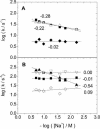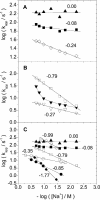Groove-binding unsymmetrical cyanine dyes for staining of DNA: dissociation rates in free solution and electrophoresis gels
- PMID: 14576311
- PMCID: PMC275464
- DOI: 10.1093/nar/gkg822
Groove-binding unsymmetrical cyanine dyes for staining of DNA: dissociation rates in free solution and electrophoresis gels
Abstract
The rates of dissociation of three non-intercalative unsymmetrical cyanine dyes, BEBO, BETO and BOXTO from mixed-sequence DNA have been studied with the DNA either free in solution or in confining porous agarose gels. The properties of the new dyes were compared to the related intercalating dyes BO, BO-PRO, TO-PRO and YO-PRO. With DNA in solution, BEBO dissociates more slowly than the monovalent BO and interestingly also more slowly than the divalent dye BO-PRO. Similarly, both BETO and BOXTO exhibit considerably slower dissociation than TO-PRO. The new dyes show biexponential dissociation kinetics in mixed-sequence DNA. The average rate of dissociation increases with increasing ionic strength, but the salt dependence of the dissociation is weaker than for the corresponding intercalating dye. The rate of dye-dissociation decreases by a factor of about 10(5) in the gel. The rates for the dyes generally follow the pattern that we observe with the DNA in free solution, however a more accentuated stabilization was seen for intercalators than for groove-bound dyes. The results show that, in particular, BOXTO is a promising candidate as a preferentially groove-bound DNA-stain with a large enhancement of the fluorescence quantum yield upon binding to DNA, and which exhibits slow and salt-insensitive dissociation compared to corresponding intercalative dyes.
Figures






Similar articles
-
Groove-binding unsymmetrical cyanine dyes for staining of DNA: syntheses and characterization of the DNA-binding.Nucleic Acids Res. 2003 Nov 1;31(21):6227-34. doi: 10.1093/nar/gkg821. Nucleic Acids Res. 2003. PMID: 14576310 Free PMC article.
-
Comparing mono- and divalent DNA groove binding cyanine dyes -- binding geometries, dissociation rates, and fluorescence properties.Biophys Chem. 2006 Aug 1;122(3):195-205. doi: 10.1016/j.bpc.2006.03.009. Epub 2006 Mar 24. Biophys Chem. 2006. PMID: 16624475
-
Syntheses and DNA-binding studies of a series of unsymmetrical cyanine dyes: structural influence on the degree of minor groove binding to natural DNA.Bioorg Med Chem. 2004 May 1;12(9):2369-84. doi: 10.1016/j.bmc.2004.02.006. Bioorg Med Chem. 2004. PMID: 15080934
-
Time-resolved electrophoretic analysis of mobility shifts for dissociating DNA ligands.Electrophoresis. 2005 Feb;26(3):524-32. doi: 10.1002/elps.200410057. Electrophoresis. 2005. PMID: 15690453
-
Cyanine dyes in biophysical research: the photophysics of polymethine fluorescent dyes in biomolecular environments.Q Rev Biophys. 2011 Feb;44(1):123-51. doi: 10.1017/S0033583510000247. Epub 2010 Nov 26. Q Rev Biophys. 2011. PMID: 21108866 Review.
Cited by
-
BENA435, a new cell-permeant photoactivated green fluorescent DNA probe.Nucleic Acids Res. 2006 Mar 17;34(5):e43. doi: 10.1093/nar/gkl011. Nucleic Acids Res. 2006. PMID: 16547198 Free PMC article.
-
Groove-binding unsymmetrical cyanine dyes for staining of DNA: syntheses and characterization of the DNA-binding.Nucleic Acids Res. 2003 Nov 1;31(21):6227-34. doi: 10.1093/nar/gkg821. Nucleic Acids Res. 2003. PMID: 14576310 Free PMC article.
-
Is photocleavage of DNA by YOYO-1 using a synchrotron radiation light source sequence dependent?Eur Biophys J. 2011 Oct;40(10):1121-9. doi: 10.1007/s00249-011-0739-7. Epub 2011 Sep 20. Eur Biophys J. 2011. PMID: 21931957
-
BOXTO as a real-time thermal cycling reporter dye.J Biosci. 2007 Mar;32(2):229-39. doi: 10.1007/s12038-007-0023-2. J Biosci. 2007. PMID: 17435315
-
Classification of Multiple DNA Dyes Based on Inhibition Effects on Real-Time Loop-Mediated Isothermal Amplification (LAMP): Prospect for Point of Care Setting.Front Microbiol. 2019 Oct 15;10:2234. doi: 10.3389/fmicb.2019.02234. eCollection 2019. Front Microbiol. 2019. PMID: 31681184 Free PMC article.
References
-
- Perkins T.T., Smith,D.E. and Chu,S. (1999) Single polymers in elongational flows: dynamic, steady-state and population-averaged properties. In Nguyen,T.Q. and Kausch,H.-H. (eds.), Flexible Polymer Chains in Elongational Flow. Springer, pp. 283–334.
-
- Smith S.B., Aldridge,P.K. and Callis,J.B. (1989) Observation of individual DNA molecules undergoing gel electrophoresis. Science, 243, 203–206. - PubMed
-
- Han J. and Craighead,H.G. (2000) Separation of long DNA molecules in a microfabricated entropic trap array. Science, 288, 1026–1029. - PubMed
-
- Becker M.M. and Dervan,P.B. (1979) Molecular recognition of nucleic acid by small molecules. Binding affinity and structural specificity of bis(methidium)spermine. J. Am. Chem. Soc., 101, 3664–3666.
Publication types
MeSH terms
Substances
LinkOut - more resources
Full Text Sources
Other Literature Sources

